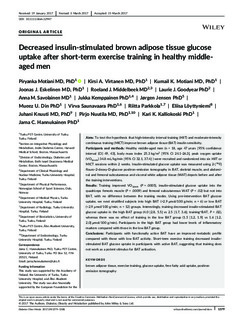Decreased insulin-stimulated brown adipose tissue glucose uptake after short-term exercise training in healthy middle-aged men
Motiani, Piryanka; Virtanen, Kirsi; Motiani, Kumail K; Eskelinen, Joonas J; Middelbeek, Roeland J; Goodyear, Laurie J.; Savolainen, Anna M; Kemppainen, Jukka; Jensen, Jørgen; Din, Mueez U; Saunavaara, Virva; Parkkola, Riitta; Loyttyniemi, Eliisa; Knuuti, Juhani; Nuutila, Pirjo; Kalliokoski, Kari K.; Hannukainen, Jarna C
Journal article, Peer reviewed
Published version
Permanent lenke
http://hdl.handle.net/11250/2498586Utgivelsesdato
2017Metadata
Vis full innførselSamlinger
- Artikler / Articles [2119]
Sammendrag
Aims: To test the hypothesis that high‐intensity interval training (HIIT) and moderate‐intensity continuous training (MICT) improve brown adipose tissue (BAT) insulin sensitivity.
Participants and methods: Healthy middle‐aged men (n = 18, age 47 years [95% confidence interval {CI} 49, 43], body mass index 25.3 kg/m2 [95% CI 24.1‐26.3], peak oxygen uptake (VO2peak) 34.8 mL/kg/min [95% CI 32.1, 37.4] ) were recruited and randomized into six HIIT or MICT sessions within 2 weeks. Insulin‐stimulated glucose uptake was measured using 2‐[18F]flouro‐2‐deoxy‐D‐glucose positron‐emission tomography in BAT, skeletal muscle, and abdominal and femoral subcutaneous and visceral white adipose tissue (WAT) depots before and after the training interventions.
Results: Training improved VO2peak (P = .0005), insulin‐stimulated glucose uptake into the quadriceps femoris muscle (P = .0009) and femoral subcutaneous WAT (P = .02) but not into BAT, with no difference between the training modes. Using pre‐intervention BAT glucose uptake, we next stratified subjects into high BAT (>2.9 µmol/100 g/min; n = 6) or low BAT (<2.9 µmol/100 g/min; n = 12) groups. Interestingly, training decreased insulin‐stimulated BAT glucose uptake in the high BAT group (4.0 [2.8, 5.5] vs 2.5 [1.7, 3.6]; training*BAT, P = .02), whereas there was no effect of training in the low BAT group (1.5 [1.2, 1.9] vs 1.6 [1.2, 2.0] µmol/100 g/min). Participants in the high BAT group had lower levels of inflammatory markers compared with those in the low BAT group.
Conclusions: Participants with functionally active BAT have an improved metabolic profile compared with those with low BAT activity. Short‐term exercise training decreased insulin‐stimulated BAT glucose uptake in participants with active BAT, suggesting that training does not work as a potent stimulus for BAT activation.
Beskrivelse
This is an open access article under the terms of the Creative Commons Attribution‐NonCommercial License, which permits use, distribution and reproduction in any medium, provided theoriginal work is properly cited and is not used for commercial purposes.
